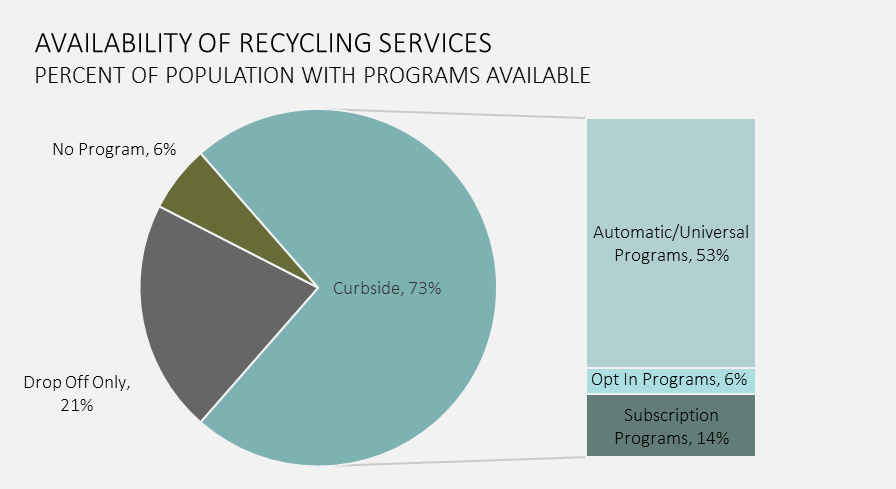THE CLIENT
The Sustainable Packaging Coalition (SPC) is an industry working group located in Charlottesville, VA, that strives to build packaging systems that encourage economic prosperity and a sustainable flow of materials. Membership includes businesses, educational institutions, government agencies and recovery/recycling entities. The SPC is a project of GreenBlue, a nonprofit whose mission is to foster a system of commerce based on the principles of sustainable materials management.
THE CHALLENGE
Measuring and analyzing the availability of residential recycling programs is important for stakeholders in the recycling industry, since having these programs available is a fundamental prerequisite for material recovery to take place. This information is also key to inform the packaging supply chain about the current availability of recycling for their products so they can be strategic in expanding recycling as an end of life solution.
Recycling availability remains a challenge to quantify, in large part due to the patchwork of different ways Americans receive recycling services – curbside, drop-off, multi-family, carts, bins, etc. And despite the Federal Trade Commission’s (FTC’s) Guides for the Use of Environmental Marketing Claims thresholds for marketing packaging as recyclable, the specifics of what counts as “availability of recycling” has been left open to interpretation and difficult to compare this measurement across different studies.
THE SOLUTION
SPC engaged RRS, with support from Moore Recycling Associates, to address these challenges by using a standardized methodology to evaluate both general characteristics of U.S. recycling programs and specific access-to-recycling metrics for a wide range of materials.
The team reviewed communities’ public-facing program materials and evaluated them for details on the program as well as accepted types of recyclable materials. Recognizing the aforementioned challenges to measuring recycling availability, the variables assessed in this study differed from those in previous studies in several key ways:
- Determination of how curbside programs are provided;
- Greater level of detail for multi-family recycling;
- Independent review of accepted materials via public-facing messaging and education practices.
THE RESULTS
The study culminated in a report describing the general findings as well as separate reports for each study funder on their materials of focus.
Key findings included:
- 94% of the U.S. population has some type of recycling program available to them, including both curbside and drop-off recycling programs.
- Curbside recycling programs are available to 73% of the U.S. population, with 53% of the population having curbside recycling “automatically” provided at their home, while the other 20% has a type of subscription or opt-in recycling program available.
- For 21% of the U.S. population, drop-off recycling programs are the only programs available.
- 21% of the U.S. population is estimated to live in communities providing a uniform collection program to residents of all building types (single-family homes, small multi-family buildings, and large multi-family complexes). Multi-family recycling was found to be commonly left to private-sector collectors or available only via drop-off.

By measuring the prevalence and characteristics of recycling collection programs, this study presents a national recycling participation snapshot, allows recycling stakeholders to identify and analyze gaps in service provision, and updates producers on the acceptance of different types of packaging in recycling programs so that informed choices can be made upstream (i.e., the packaging design phase).
The full study can be downloaded from the SPC website at: Centralized Study on the Availability of Recycling.
